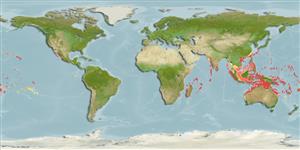Common names from other countries
Environment: milieu / climate zone / depth range / distribution range
Ecología
marino asociado a arrecife; rango de profundidad 1 - 50 m (Ref. 9710), usually 1 - 50 m (Ref. 27115). Tropical; 24°C - 28°C (Ref. 27115); 30°N - 30°S, 30°E - 89°W
Indo-pan-Pacific: East Africa to the Galapagos Is. north to southern Japan, south to the southern Great Barrier Reef and New Caledonia, Tuamotus, throughout Micronesia
Tamaño / Peso / Age
Maturity: Lm ? range ? - ? cm
Max length : 60.0 cm TL macho / no sexado; (Ref. 3145)
Espinas dorsales (total): 6; Radios blandos dorsales (total): 26-27; Espinas anales 3; Radios blandos anales: 27 - 29. Adults develop a convexly rounded prominent snout and unusually tall dorsal and anal fins. Side of body with vertical blue lines which break up into small blue spots dorsally and ventrally. A broad blue band extending from eye to front of rostral protuberance (Ref 9808).
Occurs in deep lagoon and seaward reefs. Found forming loose schools along upper regions of deep drop-offs (Ref. 48637). Forms mid-water aggregations off steep slopes during the day to feed on zooplankton. Usually found alone or in pairs. Omnivorous. Has the ability to show or hide its blue markings (Ref. 9710). Minimum depth reported taken from Ref. 27115.
Life cycle and mating behavior
Madurez | Reproducción | Puesta | Huevos | Fecundidad | Larva
Myers, R.F., 1991. Micronesian reef fishes. Second Ed. Coral Graphics, Barrigada, Guam. 298 p. (Ref. 1602)
IUCN Red List Status (Ref. 130435)
CITES (Ref. 128078)
Not Evaluated
Threat to humans
Harmless
Human uses
Pesquerías: escaso valor comercial; Acuario: Comercial
Más información
ReferenciasAcuiculturaPerfil de acuiculturaRazasGenéticaElectrophoresesheritabilidadEnfermedadesProcesamientoMass conversion
Herramientas
Special reports
Download XML
Fuentes de Internet
Estimates based on models
Preferred temperature (Ref.
115969): 25.5 - 29, mean 27.6 (based on 684 cells).
Phylogenetic diversity index (Ref.
82804): PD
50 = 0.5000 [Uniqueness, from 0.5 = low to 2.0 = high].
Bayesian length-weight: a=0.02630 (0.01537 - 0.04500), b=3.01 (2.86 - 3.16), in cm Total Length, based on LWR estimates for this species & Genus-body shape (Ref.
93245).
Nivel trófico (Ref.
69278): 2.2 ±0.11 se; based on food items.
Resiliencia (Ref.
120179): Bajo, población duplicada en un tiempo mínimo de 4.5-14 años (K=0.264; Tmax=45).
Fishing Vulnerability (Ref.
59153): Moderate vulnerability (38 of 100).
